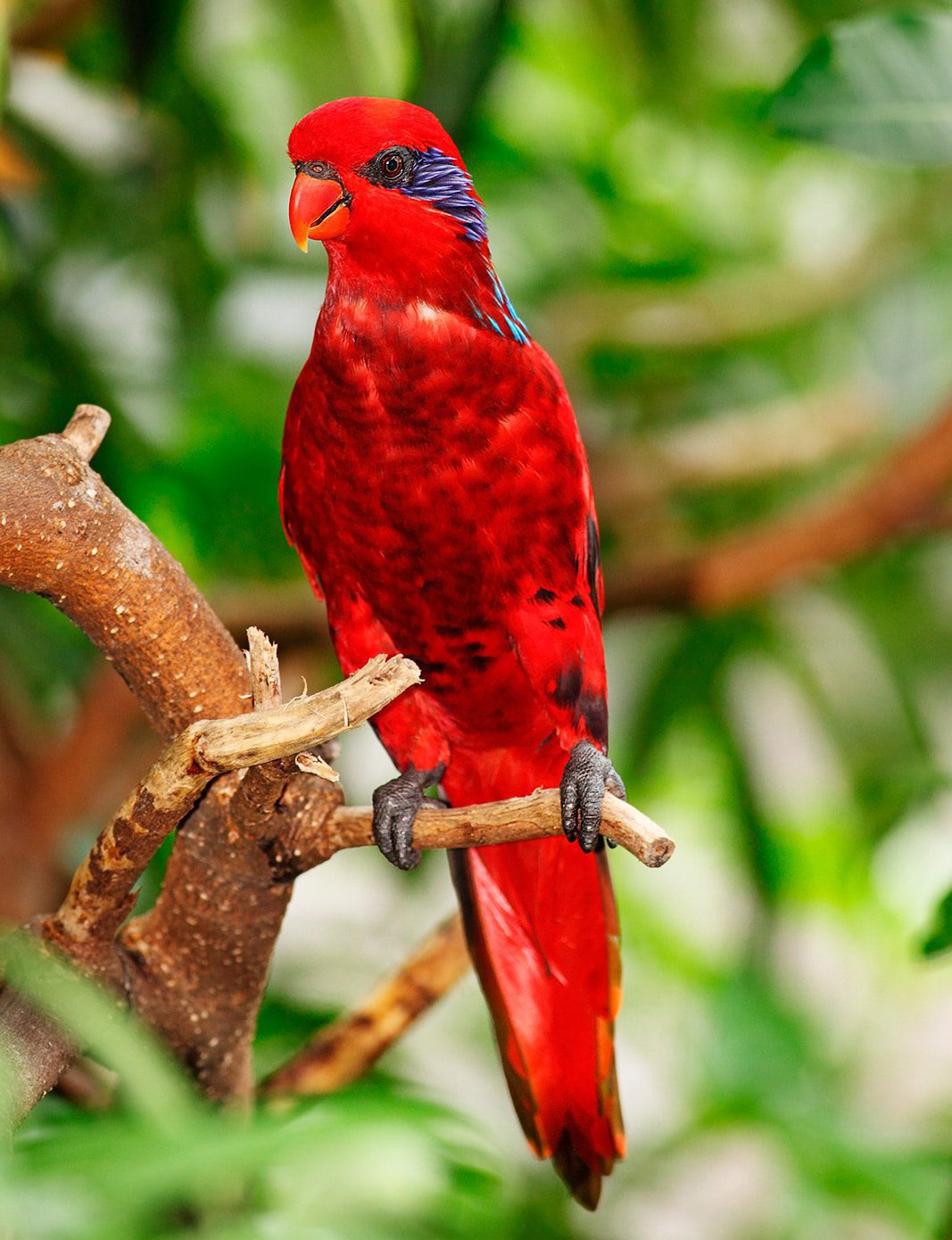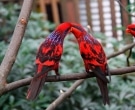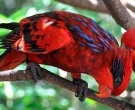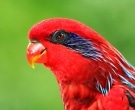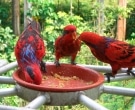Content |
|---|
Description
About 30 cm.. length and a weight between 140 and 170 gr.
Like all species of the genus Eos, the “Blue streaked Lory” (Eos reticulata), shows a beautiful plumage mainly red. In adults, a great band blue-violet crosses the region of the eye and continues in the patches that cover the ears, at the sides of the neck.
The under neck and the mantle they are covered with long, violet-blue stripes.
The back and tail they are more or less blue red striped.
The pens and large blankets have terminations in black. The primary is almost entirely black. The tail is brownish black above and below a red opaque.
The bottom of the wings they have the edge and dark tips. Thighs and flanks they are completely Red. The bill coral red. Iris orange-red. The legs are grey.
In youth , the feathers the lower parts are aligned blue-black variably. The shield It is covered with blue spots instead of stripes. The bill is brownish Orange. The irises They are brown.
- Sound of the Blue streaked Lory.
Habitat:
The Blue streaked Lory they live mostly in the most wooded areas, including primary and secondary forests. They are also found in coconut plantations, of sago palms, in the mangroves and the cultivated lands.
It seems that they show a certain attraction for the monsoon forests, relatively open and located in low-lying areas.
They live alone, in pairs or in small groups of up to ten or more individuals. These are rather shy and discreet, but their presence is often betrayed by the screams produced flocks in flight.
They have a direct flight, quite fast and composed of many flapping. Often feed on coconut blossom trees and the sago palms.
Reproduction:
There is little information of the natural environment. The Blue streaked Lory They typically make 2 or 3 eggs that colouring of 24 to 26 days. The chicks leave the nest after 7 to 8 weeks. But, even after feather, they return regularly to rest awhile. The youth they stay in the family throughout the summer and then join the dormitories where they continue their learning.
Food:
They have an exclusively vegetarian diet. They feed on fruits, seeds, buds and immature seeds. His tongue with a brush-shaped end is specialized to collect nectar and pollen.
Distribution:
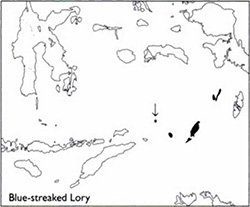
Is located in Yamdena and Larat, Tanimbar Islands and island of Babar, Indonesian. Introduced in Kai Islands and island of Damar, where has possibly gone.
Conservation:
– Current IUCN Red List category: Near threatened
– The population trend: Decreasing
Habitat loss continues apace in southern Yamdena
The species is suspected that it is decreasing at a rate of slow to moderate, due to the combined forces of habitat loss and capture.
It is estimated a population of 220.000 ± 50.000 birds in Yamdena
Nearly 3000 birds are traded on the international market of birds each year, fact that probably has not caused a decrease in its population. Habitat loss continues however, and this, combined with capture, probably if that will lead to more declines.
Conservation Actions Proposed:
– Regularly monitoring at certain sites throughout its range to determine population trends.
– Investigate the degree of capture and take appropriate measures, including the use of awareness-raising campaigns, to address these issues.
– Protection of the areas significant of forest right in all the Islands where is distributes the species.
"Blue streaked Lory" in captivity:
Lives of 15 to 30 years in the wild; and between 28 and 32 years in captivity.
Fairly common in the s 1970. Nowadays it is not unusual to see them in captivity.
Alternative names:
– Blue streaked Lory, Blue-streaked Lory (ingles).
– Lori réticulé, Lori à raies bleues, Lori strié bleu (French).
– Strichellori (German).
– Lóris-de-crista-azul (Portuguese).
– Lori de las Tanimbar, Lori Reticulado (español).
scientific classification:
– Order: Psittaciformes
– Family: Psittaculidae
– Scientific name: Eos reticulata
– Citation: (Muller,S, 1841)
– Protonimo: Psittacus reticulatus
Images “Blue streaked Lory”:
Videos "Blue streaked Lory"
————————————————————————————————————————–
“Blue streaked Lory” (Eos reticulata)
Sources:
– Avibase, BirdLife.org, Oiseaux.NET
– Photos: Wikipedia – Uploaded by Benjamint444 , Jurong Bird Park, Singapore by chong kwang (Wikimedia), Jurong Bird Park, Singapore 2 by Michael Gwyther-Jones (Wikimedia), Photographed by Benjamint444 (Wikimedia), René Modery (Wikimedia)
– Sounds: Mike Catsis (Xeno-canto)
